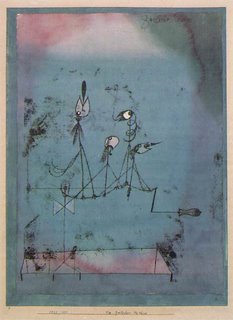paul klee @ neue galerie

i've always been an admirer of swiss artist paul klee and he's got a show at the neue galerie (this picture, Twittering Machine, is of one of his best known and one of my favorites, but wasn't at the show because MoMA owns it). i'd never been to this gallery before and though i'm still surprised when asked to pay a $10 student fare to enter a "gallery," i had already made the trek uptown, so i shelled out the dough.
probably the most interesting thing to me about seeing so much of klee's work up close and personal was the treatment of the surface, which isn't that interesting (meaning that it isn't that interesting of an observation, not that his treatment isn't interesting). i mean, it does help in communing with the artist on a more personal level, and seeing his truly incredible three-dimensional control of paint made me admire him more, and it caused his works to take on an ancient quality that is super in line with the child-like, primordial feeling in most of his art. BUT i must admit that i was more taken with other things in the gallery.
first, egon schiele. i've always loved him (it's difficult not to, i think), but since a show of his that i recently saw at Galerie St. Etienne (note: it's free) i'm taken by him in a completely new and...well, rapturous way. he developed a style and a command and use of color that were so perfectly suited to his own distinctive purpose. (i think the connection with him has to do with the fact that he is a figurative artist and so is able to convey human emotion more clearly, but i'm not completely sure (there are abstract artists who i like more than figurative ones, of course, and i like other figurative artists less and more than schiele)). but i think the main thing is his use of line:
it made me think of jackson pollock, and the tired old interpretation that pollock's painting style is the supreme recording of the physical creation of the line, and that therefore his paintings allow us to connect with the artist because of the hyper bodily movements recorded in his splashings of paint. but just because pollock moved around like a mad man over his canvas doesn't mean that those types of lines are the best ones through which to communicate with a viewer. it's so blatantly obvious, to me at least, that the slow, purposeful tracing of a pencil on a piece of paper, which created the types of lines in schiele's work, are a far more powerful way of recording an individual's movements and communicating the personal quality of that act, and the more i think about pollock the more i think that the absolute only reason to admire him is because he did something that was radical for the time, but not at all because of the form of the act.
this was reinforced by something else i thought of at the gallery, which is a collection not only of paintings from turn of the century germany and austria, but also of decorative arts, including jewelry, tableware and furniture (go with me on this). normally, i don't care much for industrial and graphic design; i've seen it as somewhat empty and part of an upper class preoccupation with material items (which, of course, it is, and -- okay -- the visual arts are too to some extent, but at least they have the potential to be something more pure). but graphic/industrial design have a value beyond the material that connects to the value i see in schiele, and klee too, and which pollock doesn't have. and that is the pure creation of a style.
style exists in every medium -- literature, music, fashion, theater, etc. -- and it's one of the great things that a human being can create and which other human beings can perceive and appreciate. (because i've read so much of him recently, i'm thinking of the writing of ian frazier as a very strong example of a superb literary style.) the germans and austrians during the turn of the century -- the work that is exhibited at the neue -- had an exceptionally strong and maybe even cohesive style that extended across many media. being in the gallery, you just feel it. by contrast, i don't feel pollock to be an expression of his time and place at all, and compared with all of the writers, playwrites and visual artists i'm thinking of, he's just got no style. he found something that worked (i've argued elsewhere that his motivations were largely economic, but i'm not gonna go there right now) and he made a ton of paintings in that same model.
i should probably put a little more thought into a definition of style in order to make this point stronger, but i'm too tired right now. also i hate to end on a negative note, so one last thing: i really liked some of the gustav klimt works in the gallery, most especially The Black Feather Hat (this link does not do the colors justice). good god, it's an excellent painting. to me, it felt more mature than the later style that he eventually perfected and became known for. this painting alone made the trip to the gallery worth it.

1 Comments:
شركات تطهير الفلل في دبي
شركات التعقيم في الإمارات
Post a Comment
<< Home